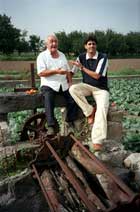
Slow Food Revolution 2003
Distributed by Filmakers Library, 124 East 40th Street, New York, NY 10016; 202-808-4980
Produced by Carmelo Musca
Directed by Carlo Buralli
VHS, color, 52 min.
Jr. High - Adult
Food, Multicultural Studies, Sociology
Date Entered: 12/02/2005
Reviewed by Janis Tyhurst, Reference Librarian, George Fox UniversityThe Slow Food Movement came into being in 1989 in Paris France. The mission of the Slow Food Movement is to ‘link[s] pleasure and food with awareness and responsibility.’ The documentary gives a compelling overview of the philosophy and activities of the organization. The film takes the viewer to several places in Italy, Mexico, and Australia to see what members of the Slow Food Movement are doing in those areas. In Italy, an heirloom tomato has been brought back from the brink of extinction; in Mexico farmers are returning to more eco-friendly and traditional crops such as vanilla and amaranth. An urban Australian elementary school has started a garden, allowing the students to participate in the planting, raising and consuming of the produce raised, helping them to understand the wonder of creating and enjoying the fruits of their labor. One common thread that links all the countries is that the traditional means of farming or cooking or reviving near extinct food plants is a simple yet profound means of maintaining cultural integrity and identity, as well as allowing people to reconnect with one another in a less frenetic world. At one point in the story, two different people talk of the connection between the foods we eat and our identity. One Mexican farmer says that ‘food goes beyond the biological fact of eating’ and an Australian teacher says ‘My first exposure to another culture was through eating their food.’ In a sense the Slow Food Movement is the antithesis of globalization and genetically modified foods—those forces that try to make the world uniform and flat.